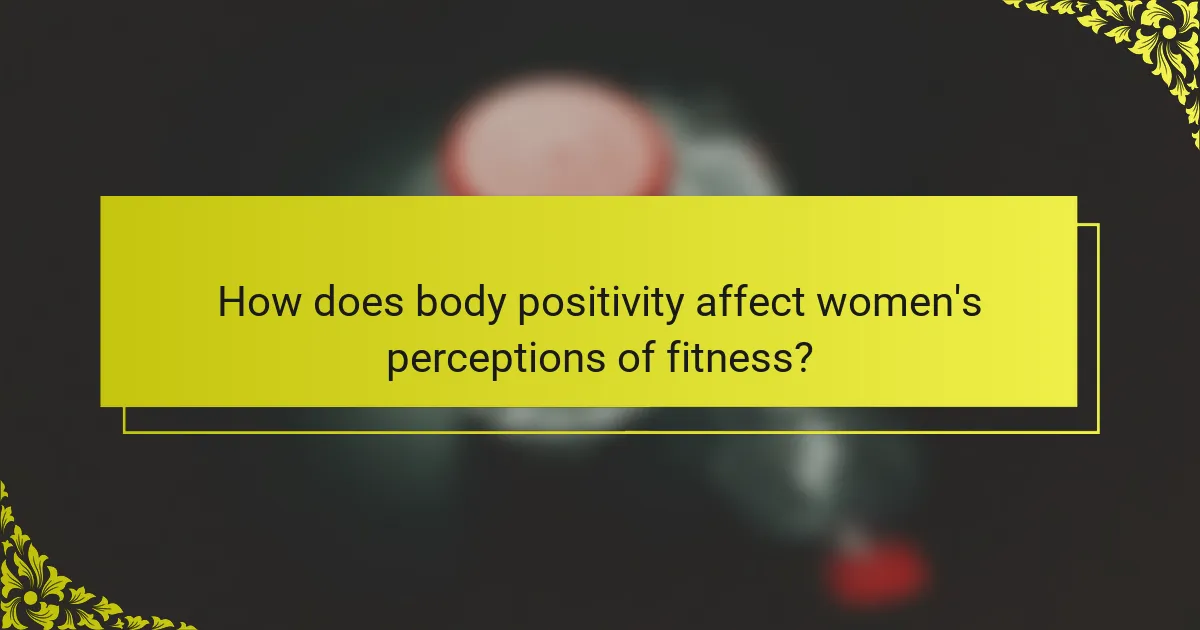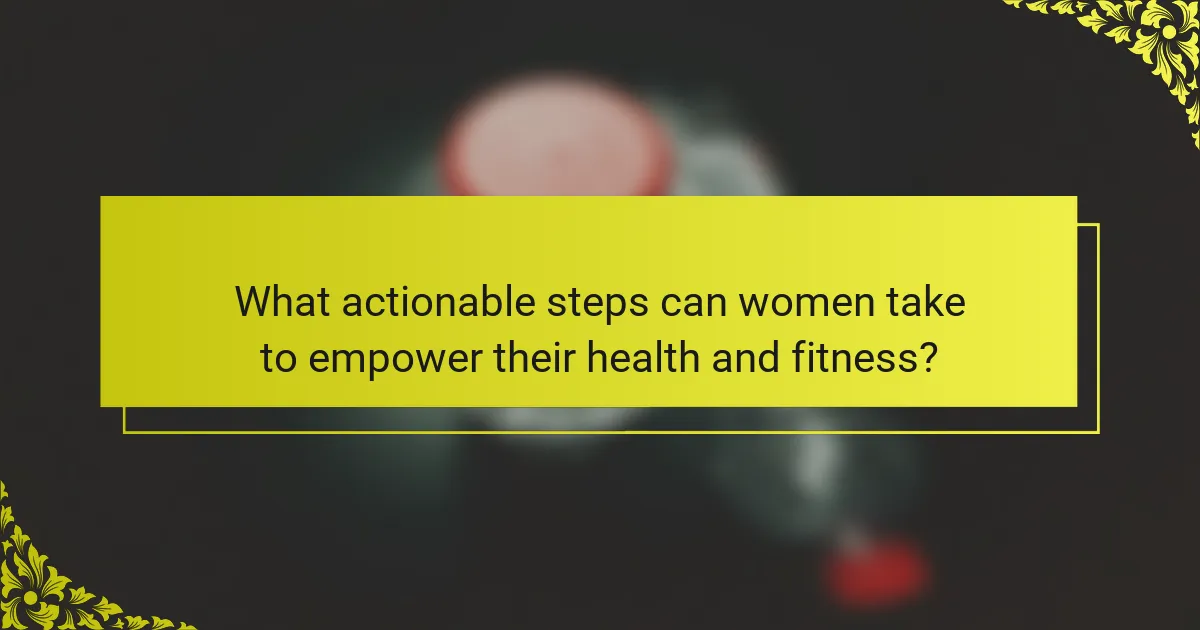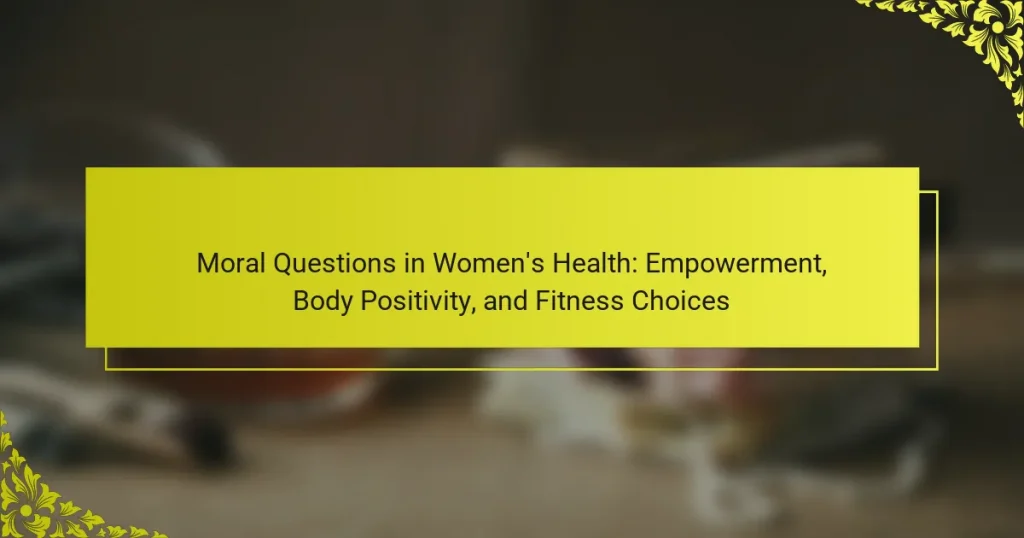Moral questions in women’s health focus on empowerment, body positivity, and fitness choices. Empowerment enhances autonomy and informed decision-making, while body positivity promotes self-acceptance and reduces stigma. Fitness choices are influenced by societal pressures and access to resources. Understanding these dynamics is crucial for fostering holistic well-being in women’s health.

What are the moral implications of empowerment in women’s health?
Empowerment in women’s health raises significant moral questions regarding autonomy, body positivity, and informed choices. It challenges traditional norms that often dictate women’s roles in healthcare decisions. Empowerment fosters self-advocacy, enabling women to make informed decisions about their bodies and health.
For instance, studies show that women who feel empowered in their healthcare experiences report higher satisfaction and better health outcomes. However, empowerment can also lead to moral dilemmas, such as the pressure to conform to societal standards of health and beauty. This duality emphasizes the need for a supportive environment that respects individual choices while promoting holistic well-being.
Ultimately, the moral implications of empowerment in women’s health hinge on balancing personal agency with societal expectations, ensuring that women can navigate their health journeys authentically and confidently.
How does empowerment influence women’s fitness choices?
Empowerment significantly enhances women’s fitness choices by fostering confidence and autonomy. Women who feel empowered are more likely to engage in physical activities that align with their personal values and goals. This empowerment leads to a greater focus on body positivity, enabling women to prioritize fitness for health rather than societal pressures. Studies indicate that empowered women often choose diverse forms of exercise, such as yoga or strength training, which reflect their individual preferences. Additionally, empowerment encourages community support, promoting shared experiences that enhance motivation and commitment to fitness.
What role does self-advocacy play in women’s health?
Self-advocacy is crucial in women’s health as it empowers women to make informed decisions about their bodies and healthcare. This empowerment fosters body positivity and encourages women to prioritize their fitness choices. Studies show that women who advocate for themselves experience better health outcomes and increased satisfaction with care. By actively participating in health discussions, women can challenge societal norms and promote a more inclusive approach to wellness.
What are effective strategies for self-advocacy?
Effective self-advocacy strategies include understanding your rights, communicating clearly, and seeking support from others. Empowerment in women’s health involves recognizing personal needs and asserting them confidently. Developing body positivity enhances self-esteem, which aids in advocating for health choices. Engaging in fitness choices that reflect personal values fosters a sense of ownership over one’s health journey.

How does body positivity affect women’s perceptions of fitness?
Body positivity significantly enhances women’s perceptions of fitness by promoting self-acceptance and reducing stigma. This movement encourages women to embrace diverse body types, leading to increased motivation for physical activity. Studies show that women who adopt body-positive attitudes are more likely to engage in fitness without the pressure to conform to unrealistic standards. As a result, they experience improved mental health and overall well-being, reinforcing the importance of empowerment in fitness choices.
What are the psychological benefits of body positivity in fitness?
Body positivity in fitness enhances mental well-being by fostering self-acceptance and reducing anxiety. It promotes a healthier relationship with exercise, encouraging individuals to focus on personal growth rather than societal standards. This shift can lead to improved body image, increased motivation, and greater overall satisfaction with fitness routines. Studies show that individuals embracing body positivity experience lower levels of depression and higher self-esteem, contributing to a more sustainable fitness journey.
How can body positivity combat societal beauty standards?
Body positivity can effectively challenge societal beauty standards by promoting self-acceptance and diverse representations of beauty. This movement empowers individuals to reject narrow definitions of attractiveness, fostering a healthier relationship with their bodies. As a result, it encourages a culture that values personal worth over physical appearance, which can lead to improved mental health and self-esteem. By embracing body positivity, society can shift towards inclusivity, ultimately redefining beauty standards to reflect a broader spectrum of identities and experiences.

What unique challenges do women face in fitness choices?
Women face unique challenges in fitness choices, including societal pressures, body image issues, and access to resources. These factors often lead to feelings of inadequacy and hinder participation in fitness activities.
Societal expectations can dictate what is deemed acceptable for women’s bodies, influencing their motivation and confidence. Many women experience pressure to conform to idealized body types, which can deter them from pursuing fitness that aligns with their personal goals.
Body positivity movements aim to combat these pressures, yet women still struggle to find inclusive spaces that support diverse body types. This lack of representation can diminish their engagement in fitness communities.
Access to fitness resources varies significantly, with women in certain demographics facing barriers such as affordability and availability of safe exercise environments. These challenges can limit their ability to make empowered fitness choices that promote overall health and well-being.
How do cultural norms influence women’s fitness decisions?
Cultural norms significantly shape women’s fitness decisions by influencing their perceptions of body image and health. Social expectations often dictate the types of physical activities women engage in, prioritising aesthetics over well-being. For instance, societal ideals may pressure women to pursue specific body types, impacting their motivation and choices in fitness. Moreover, cultural attitudes toward femininity and strength can either empower women or create barriers to participation in certain sports or exercise routines. This interplay between societal values and personal choices highlights the importance of promoting body positivity and diverse representations in fitness to encourage healthier decisions.
What are the impacts of social media on women’s body image?
Social media significantly influences women’s body image, often promoting unrealistic standards. The constant exposure to curated images can lead to self-comparison, fostering feelings of inadequacy. A study found that 70% of women reported feeling pressure to look a certain way due to social media. This environment can hinder body positivity and empowerment, as women may prioritise appearance over health. Social media can also offer supportive communities that promote fitness choices and self-acceptance, highlighting the dual impact on women’s health.
What are the best practices for navigating fitness-related social media?
To navigate fitness-related social media effectively, focus on authenticity and positive engagement. Prioritise content that promotes body positivity and empowerment. Follow credible influencers who align with your values and encourage healthy fitness choices. Engage with supportive communities to foster a positive environment. Avoid comparison and remember that individual fitness journeys vary significantly.

What are the rare but significant factors affecting women’s health choices?
Women’s health choices are significantly influenced by moral questions surrounding empowerment, body positivity, and fitness. Rare factors include cultural stigma, socioeconomic status, and access to information. Cultural stigma can deter women from pursuing certain health practices. Socioeconomic status affects access to resources and healthcare options. Access to information shapes women’s understanding of health choices and empowerment. These elements create a complex landscape for women’s health decisions.
How do intersectional identities shape women’s health experiences?
Intersectional identities significantly influence women’s health experiences by shaping access to resources and perceptions of wellness. Factors such as race, socioeconomic status, and cultural background impact how women perceive body image and fitness. For example, women from marginalised communities may face unique barriers to health services, affecting their overall empowerment and body positivity. Research indicates that these identities can lead to varying health outcomes, emphasising the need for tailored health interventions that consider these diverse experiences. Addressing intersectionality in women’s health promotes inclusivity and better health outcomes.
What role do healthcare disparities play in women’s fitness?
Healthcare disparities significantly hinder women’s fitness by limiting access to resources and support. Factors such as socioeconomic status, race, and geographic location influence women’s ability to engage in fitness activities. For instance, women in low-income areas may lack access to gyms or safe outdoor spaces. Additionally, cultural attitudes toward body image can discourage participation in fitness programs. Addressing these disparities is essential for promoting empowerment and body positivity among women, enabling them to make healthier fitness choices.

What actionable steps can women take to empower their health and fitness?
Women can empower their health and fitness by adopting actionable steps focused on body positivity and informed choices. Prioritise self-acceptance to foster a positive body image, which enhances motivation. Incorporate regular physical activity tailored to personal preferences, promoting both mental and physical well-being. Educate yourself on nutrition, emphasising whole foods that nourish the body. Set realistic fitness goals to maintain motivation and track progress. Seek supportive communities that encourage healthy habits and share experiences. Lastly, practice mindfulness to connect with your body and recognise its unique strengths.
What are the top strategies for fostering body positivity in daily life?
To foster body positivity in daily life, practice self-acceptance, promote diverse body representations, and engage in supportive communities. Focus on positive self-talk, challenge societal standards, and celebrate individual uniqueness. These strategies empower women to embrace their bodies and enhance overall well-being.
How can women create a supportive fitness community?
Women can create a supportive fitness community by fostering inclusivity, sharing experiences, and encouraging each other. Establishing safe spaces for discussions about body positivity and fitness choices is essential. Organising group workouts and social events can enhance connections. Utilising social media platforms allows for broader outreach and engagement. Collaborating with local gyms or wellness centres can provide resources and expertise. Prioritising empowerment through shared goals and mutual support strengthens community bonds.
What resources are available for building a supportive network?
Building a supportive network involves accessing various resources tailored to women’s health. Community health organisations provide workshops on empowerment and body positivity. Online forums and social media groups facilitate connection and sharing of fitness choices. Local fitness centres often host classes focusing on women’s health. Health professionals can offer personalised guidance and support.




